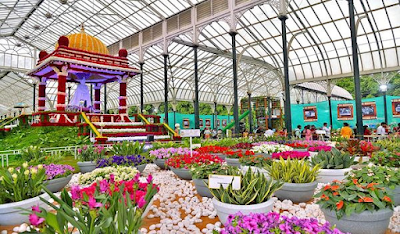Chikamagalur
Chikamagalur, located in the state of Karnataka, India, is a picturesque hill station known for its coffee plantations, scenic landscapes, and serene environment. Here’s a detailed guide to some of the top tourist attractions in Chikamagalur:
 |
| Chikmagalur |
Mullayanagiri
Description: The highest peak in Karnataka, standing at 1,930 meters above sea level.
Activities: Trekking, sunrise and sunset views, and photography.
Special Note: The trek is moderate and offers stunning views of the Western Ghats.
 |
| Mullayanagiri |
Baba BudangiriDescription: A mountain range named after the Sufi saint, Baba Budan.
Activities: Trekking, visiting the shrine of Baba Budan, and exploring nearby caves.
Special Note: Known for its beautiful vistas and trekking trails.
 |
| Baba Budan giri |
Hebbe FallsDescription: A spectacular waterfall located in the Kemmangundi hill station.
Activities: Trekking through coffee estates to reach the falls, enjoying the waterfall.
Special Note: The falls are divided into two stages – Dodda Hebbe (Big Falls) and Chikka Hebbe (Small Falls).
 |
| Hebbe Falls |
Coffee PlantationsDescription: Chikkamagaluru is known as the coffee land of Karnataka.
Activities: Plantation tours, coffee tasting, and learning about coffee production.
Special Note: Many estates offer homestays for a unique experience.
 |
| Coffee Plantation |
KemmangundiDescription: A hill station with lush gardens, beautiful valleys, and waterfalls.
Activities: Trekking, exploring the Raj Bhavan, and visiting the Z Point for sunset views.
Special Note: Known for its panoramic views and pleasant climate.
 |
| Lush Greenery |
Sringeri Sharada PeethamDescription: An ancient temple dedicated to Goddess Sharadamba, established by Adi Shankaracharya.
Activities: Pilgrimage, exploring the temple architecture, and participating in spiritual activities.
Special Note: Situated on the banks of the Tunga River, offering a tranquil environment.
 |
| Beautiful View |
Hirekolale LakeDescription: A man-made lake surrounded by hills and coffee plantations.
Activities: Boating, picnicking, and enjoying the scenic beauty.
Special Note: A perfect spot for sunset photography.
 |
| Natural View |
Horanadu Annapoorneshwari TempleDescription: A revered temple dedicated to Goddess Annapoorneshwari.
Activities: Pilgrimage, exploring the temple premises, and receiving the prasadam (blessed food).
Special Note: Located in a picturesque valley, offering a peaceful ambiance.
 |
| Anna poorneshwari Temple |
Travel TipsBest Time to Visit: September to March for the best weather.
Accommodation: Options range from budget hotels to luxury resorts and homestays, especially within coffee plantations.
Chikamagalur offers a blend of adventure, natural beauty, and spiritual experiences, making it a versatile destination for all types of travelers.






















































